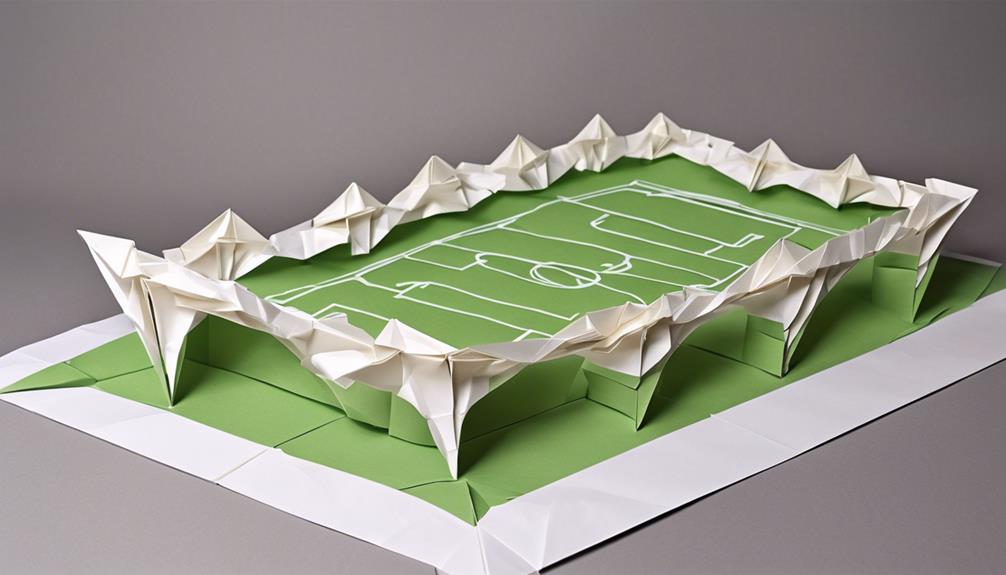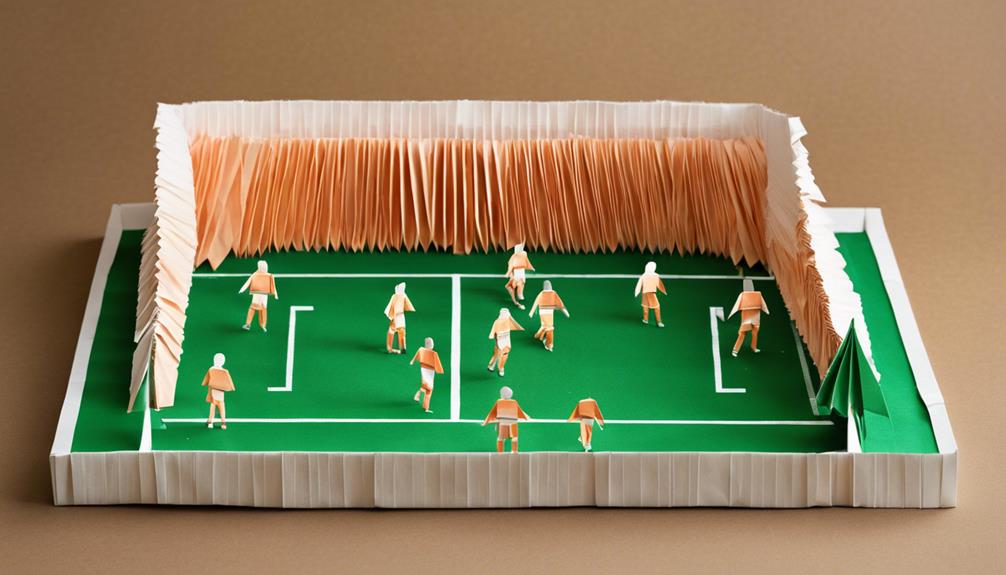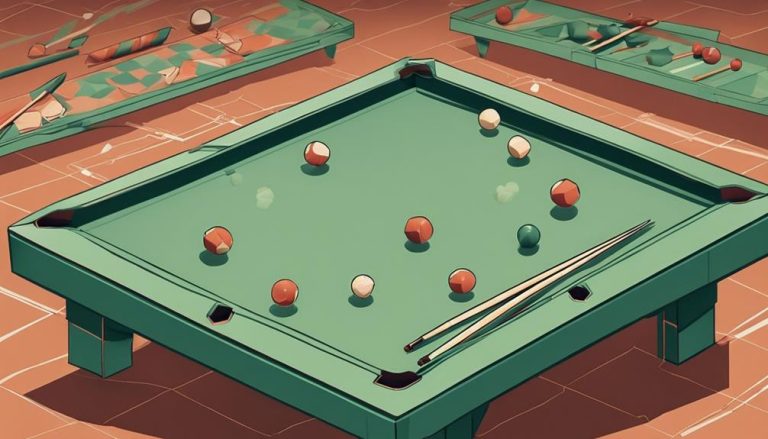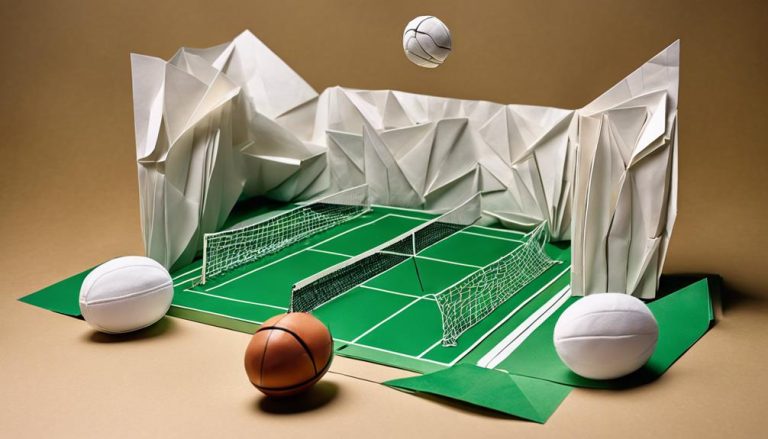General Rules of Five a Side Football
You're about to plunge into the world of five-a-side football, where the rules are tweaked to amplify the excitement and intensity of the beautiful game. The pitch is typically 20-25 yards wide and 30-40 yards long, with goals at each end. A standard match is divided into two 25-minute halves, with the referee adjusting the game length as needed. Fouls, free kicks, and penalty kicks are all part of the game. As you step onto the pitch, remember that the referee's decisions are final, and respect for their authority is key. Now, get ready to discover the finer details that'll take your five-a-side skills to the next level.
Pitch Dimensions and Markings

You'll play five-a-side football on a pitch that's typically 20-25 yards wide and 30-40 yards long, with markings that include goals, penalty spots, and center lines. The pitch orientation is usually rectangular, with the longer sides being the touchlines and the shorter sides being the goal lines. The field layout typically consists of a flat, smooth surface, free from obstacles and hazards.
The pitch markings are vital in five-a-side football, as they define the playing area and guide the players' movements. The goals, usually 3×2 meters in size, are positioned at each end of the pitch. The penalty spot, marked 6-8 meters from the goal line, is where penalty kicks are taken. The center line divides the pitch into two halves, and the center circle marks the starting point of the game.
Understanding the pitch dimensions and markings is essential for a player to navigate the game effectively. Familiarity with the pitch layout allows you to anticipate the game's flow, make strategic decisions, and express your creativity on the field.
Player Numbers and Substitutions
Comprising five outfield players and one goalkeeper, each team takes to the pitch with a carefully selected squad, with substitutions allowed throughout the game. As you assemble your team, think about the importance of squad depth, as it can greatly impact your team's performance. You'll want to balance your starting lineup with a strong bench, ensuring seamless handovers during substitutions. A well-rounded squad enables you to adapt to different game scenarios, exploiting opponents' weaknesses and covering your own vulnerabilities.
When making substitutions, remember that team dynamics play a vital role. You'll need to take into account the chemistry between players, ensuring that new entrants gel with the existing lineup. This harmony is key to maintaining momentum and avoiding disruptions to your team's rhythm. With the freedom to make substitutions, you can adjust your strategy mid-game, injecting fresh legs or altering your formation to catch your opponents off guard. By mastering the art of substitutions, you'll tap into the full potential of your squad, giving you a competitive edge in the world of five-a-side football.
Ball Size and Weight

In five-a-side football, the ball's dimensions and mass are vital factors, with official regulations stipulating that the ball should be circumference 68-70 cm and weigh between 420-450 grams at the start of the match. As a player, you should verify that the ball meets these standards to guarantee a fair and enjoyable game. The ball's weight and size are pivotal in determining its aerodynamics, bounce, and overall performance.
The ball's material options are also vital, with most five-a-side balls made from high-quality, synthetic leather or polyurethane. These materials provide durability, water resistance, and a consistent playing experience. When it comes to inflation, the ball should be inflated to the recommended pressure, usually between 0.8 and 1.2 bar, to achieve peak performance. Checking the ball's inflation regularly is vital, as under-inflation can affect the ball's movement and bounce. By adhering to these standards, you'll be able to play a high-quality game that's both fun and competitive.
Game Length and Stoppages
Now that you've verified the ball meets the official standards, it's time to focus on the game's duration and interruptions. In a standard five-a-side match, the game is divided into two halves, each lasting 25 minutes. However, the referee can adjust the game length based on factors like player injuries, weather conditions, or other unforeseen circumstances.
Game interruptions, such as fouls, injuries, or disputes, can profoundly impact the game's flow and duration. Effective time management is vital to maintain a smooth and enjoyable game. The referee is responsible for managing the game clock, stopping the clock during interruptions, and adding time for lost play. You should be aware that the referee's decisions regarding game interruptions and time management are final.
It's essential to understand that game interruptions can affect the outcome of the match. As a player, it's vital to adapt to the game's rhythm and flow, adjusting your strategy accordingly. By understanding the rules governing game length and stoppages, you'll be better equipped to navigate the game's twists and turns, ultimately enhancing your overall playing experience.
Scoring System and Goals

You'll need to understand the scoring system and goal rules to maximize your chances of winning a five-a-side match. A goal is scored when the ball passes completely over the goal line between the goal posts and under the crossbar. The team with the most goals at the end of the game wins.
A goal can be scored from anywhere on the field, including from a rebound or a deflection.
A goal can be scored with any part of the body, except the hands and arms, which are only allowed for the goalkeeper in their own penalty area.
Goal celebrations should be kept brief and respectful, avoiding excessive time-wasting or unsportsmanlike behavior.
The goalkeeper's psyche plays a vital role in the game, as they must remain focused and composed under pressure.
In the event of a tied score at the end of the game, the match may go into extra time or be decided by a penalty shootout, depending on the tournament rules.
Understanding these scoring system and goal rules will help you make the most of your five-a-side game and increase your chances of victory.
Fouls and Misconduct Rules
Committing fouls can cost your team dearly, so it's essential that you understand what constitutes a foul and how it's penalized. A foul is considered unfair or unsafe behavior, including tripping, pushing, or holding an opponent. If you're found guilty of foul play, the referee may issue a Yellow Card, which serves as a warning. However, if your behavior is deemed more severe, such as violent conduct or spitting, you'll receive a Red Card, resulting in immediate ejection from the game.
It's crucial to maintain Fair Play and avoid Aggressive Behavior, as it can lead to disciplinary action. Simulated Fouls, where you pretend to be fouled, are also penalized. Remember, the referee's decision is final, so it's essential to respect their calls. By understanding and adhering to these rules, you can ensure a safe and enjoyable game for all players.
Restarts and Free Kicks

Restarting play efficiently is imperative, as it allows your team to quickly regain possession and maintain momentum, especially after a foul or infringement. In five-a-side football, restarts are pivotal in deciding the outcome of the game. You need to be aware of the different types of restarts, including kickoffs, free kicks, and penalty kicks.
Kickoff strategies can greatly impact the game's momentum. A well-executed kickoff can catch the opposing team off guard and create scoring opportunities.
Free kicks can be either direct or indirect, depending on the type of foul committed.
The referee's decision on the type of free kick is final, so respect for their call is necessary.
Penalty kicks are awarded when a foul occurs inside the penalty area, and a goal can be scored directly from the spot.
Fair play is necessary in restarts, as unsportsmanlike conduct can result in disciplinary action.
Ball In and Out of Play
When the ball crosses the touchline or goal line, it's out of play, and you're likely to find yourself restarting with a throw-in, corner kick, or goal kick, depending on which team last touched the ball. Understanding what constitutes a ball in or out of play is essential to avoiding boundary disputes and touchline drama. Remember, if the ball crosses the goal line between the goal posts and under the crossbar, it's a goal – regardless of who touched it last. If it crosses the goal line outside the goal posts, it's a goal kick or corner kick. When the ball crosses the touchline, it's a throw-in or a kick-in, depending on which team touched it last. Don't get caught up in disputes over whether the ball is in or out – focus on the game and let the rules guide you. By knowing these simple rules, you'll be free to focus on your game, and your team will reap the benefits.
Referee Decisions and Authority

As you step onto the five-a-side pitch, you need to understand that the referee's word is law. When a decision is made, it's final, and arguing won't change it. You're expected to respect their authority and accept their calls, even if you disagree with them.
Referee's Final Decision
In a five-a-side football match, you're bound by the referee's final decision, which is absolute and cannot be disputed. This means that once the referee makes a call, it's final, and you can't argue with it. This rule is in place to maintain order and facilitate the game flows smoothly.
While referees aim to be impartial, referee bias can sometimes be a concern. However, remember that referees are human, and occasional mistakes can happen. To mitigate this, referees undergo extensive training to promote decision consistency.
Some key points to keep in mind:
- Referees are trained to make quick decisions, and their calls are often based on their best judgment at the time.
- Referees are responsible for enforcing the rules, and their decisions are binding.
- Referee bias can occur, but it's rare, and referees are trained to remain unbiased.
- Consistency is vital, and referees aim to make fair and consistent calls throughout the game.
- Respect for the referee's final decision is vital to maintaining a positive and respectful game environment.
Respect for Authority
By respecting the referee's authority, you acknowledge that their decisions are final, and you're more likely to maintain a positive and respectful attitude throughout the game. This respect is vital in five a side football, as it facilitates a smooth and enjoyable experience for all players involved. Remember, referee respect is a two-way street; when you respect their authority, they're more likely to respect you and your teammates in return.
As an authority figure, the referee's primary role is to enforce the rules and maintain order on the pitch. By respecting their decisions, you're acknowledging their expertise and trust their judgment. This doesn't mean you can't question a call or ask for clarification; however, you must do so in a respectful and courteous manner. Remember, the referee's word is final, and arguing or disputing their decisions can lead to unnecessary tension and conflict. By respecting their authority, you're contributing to a positive and respectful game environment, which is vital for a fun and enjoyable experience.
Frequently Asked Questions
Can Players Wear Jewelry or Accessories During a Game?
You're allowed to wear jewelry or accessories with religious or cultural significance during a game, as long as they don't pose a safety risk; however, you must make sure to check with the referee or league officials beforehand to avoid any issues.
Can a Team Request a Referee Change During a Match?
"Imagine a referee, whistle in hand, moonlighting as a dictator, ruling with an iron fist. Sorry, but you can't just swap them out mid-game, citing referee bias or game disruption – the show must go on, friend!"
Are There Specific Rules for Players Wearing Glasses or Contacts?
You're wondering about vision correction on the pitch. Rest assured, you can wear glasses or contacts for eye protection; just verify they're securely fitted and won't cause injury to yourself or others.
Can Coaching Staff or Spectators Enter the Playing Area?
Imagine you're at a high-stakes tennis match, where a coach's sudden appearance on court would be unthinkable. Similarly, in five-a-side football, coaching staff or spectators must respect Field Boundaries and Sideline Etiquette, staying clear of the playing area to avoid disrupting the game's flow.
Are There Any Rules for Extreme Weather Conditions During a Game?
When you're playing, you'll need to know that games can be delayed or cancelled due to Weather Cancellations, prioritizing player safety during extreme conditions, especially with Lightning Safety protocols in place to guarantee your protection.






